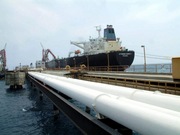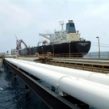
Samsun-Ceyhan Pipeline Project Designed to Divert Kazakhstani Oil
Publication: Eurasia Daily Monitor Volume: 6 Issue: 195
By:

Russia and Turkey, with Italy in tow, have seemingly struck a grand oil and gas bargain in the Black Sea. On October 19 in Milan, government ministers and corporate officials from the three countries signed agreements to move ahead with the Russian South Stream gas pipeline on the seabed and, concurrently, a Novorossiysk-Samsun-Ceyhan oil transport system centered on a pipeline across Anatolia.
Italy’s state-controlled energy conglomerate ENI is involved in both projects, thanks to its close relations and those of Prime Minister Silvio Berlusconi with Moscow. The agreements just signed, however, amount to a bilateral quid-pro-quo between Russia and Turkey (Interfax, Anatolia News Agency, October 19, 20).
The Turkish government authorized Russia’s Gazprom to conduct exploration work on the seabed in Turkey’s Black Sea exclusive economic zone, in preparation (or so it seems) for laying the South Stream pipeline’s seabed section. In return, Russia agreed to supply oil into the Samsun-Ceyhan pipeline, to run through Turkish territory from the Black Sea to the Mediterranean. This line, with a proposed capacity of the same magnitude as the Baku (Azerbaijan)-Ceyhan pipeline, would mainly carry Kazakhstani oil, to be delivered by Russia through the port of Novorossyisk into the Black Sea.
This quid-pro-quo was first outlined publicly during Russian Prime Minister Vladimir Putin’s August 6 visit in Ankara (EDM, August 7, 8, 9). It does not entail any promise of South Stream gas supplies to Turkey. This would be unnecessary, since Russia already covers three quarters of Turkey’s gas consumption, in a saturated market. Turkey’s reward is the Samsun-Ceyhan oil transport project in return for cooperating with South Stream.
Russia’s gain is two-fold. In a virtual sense it maintains an appearance of movement on the South Stream project, despite the lack of gas supplies and financing for that project even at the declarative level. Russia is trying to generate an artificial bandwagon effect with South Stream in order to cast doubt on the viability of the European Union-backed Nabucco project.
In a material sense, however, Russia stands to gain major advantages in the contest for the transportation of Caspian oil, if the Samsun-Ceyhan pipeline is built and operates as intended. This line would enable Russia to consolidate its control over the transportation of Kazakhstani oil to international markets via Russian territory, adding to Moscow’s already strong leverage on Kazakhstan and on Western oil companies operating there.
Nearly 80 percent of oil exports from Kazakhstan flow through Russian pipelines and ports at present (a share basically unchanged for the last decade). Western companies extract most of that oil and have also built the largest export pipeline: the Caspian Pipeline Consortium (CPC) line from Tengiz via Russia to Novorossiysk. Oil production in Kazakhstan is set to increase dramatically in the decade ahead, as currently operating fields approach the peak phase and the world-class Kashagan offshore field comes on stream. That production requires outlets and Moscow insists that these are, again, Russian outlets, primarily Novorossiysk on the Black Sea.
To that end, Moscow is pressuring Western oil companies in Kazakhstan to finance an expansion of the CPC pipeline’s capacity, more than doubling it to 65 million tons per year. This could absorb the lion’s share of the new production of Kazakhstani oil during the next decade, including Kashagan production. As a net result, Moscow would maintain (in relative terms) and massively increase (in absolute terms) Russian intake of Kazakhstani oil. By the same token, Russia would have minimized the share of Kazakhstani oil exports westward across the Caspian Sea and the South Caucasus, which can flow through Georgian Black Sea ports to Europe or through Turkey to the Mediterranean.
Moscow’s strategy presupposes opening a new outlet from the Black Sea to take Kazakhstani oil (and some volumes of Russian oil) to the Mediterranean, bypassing the overcrowded Bosporus Strait. A Samsun-Ceyhan pipeline, to run through central Anatolia from the Black Sea to the Mediterranean, is the solution that Russia needs to maintain control over Kazakhstani oil exports and leverage over Western oil companies in that country.
Turkey’s AKP government is keen to cooperate with Moscow’s strategy, to the detriment of Ankara’s Turkic and Western partners. Samsun-Ceyhan is a project that gratifies the government’s ambition to turn Turkey into an “energy hub country.”
The line would run approximately 550 kilometers across Anatolia from coast to coast. Its proposed capacity is 50 million tons annually, potentially to be increased to 75 million tons in a follow-up stage. Investment costs are officially estimated at $ 1.5 billion, which is almost certainly an underestimate, given the route’s length and highly challenging terrain in central Anatolia. The stakeholders in the Trans-Anatolian Pipeline Company (TAPCO) are ENI and the Turkish conglomerate Ahmed Calik’s subsidiary, Calik Energy, with stakes of 50 percent each (Interfax, Anatolia News Agency, October 19, 20).
In an accompanying memorandum of understanding, Russian state-owned companies Transneft and Rosneft hold out the promise of supplying crude oil for transportation through the Samsun-Ceyhan pipeline. The Russian maritime shipping company Sovkomflot, also state-owned, would transport oil by tankers from Novorossiysk and other Black Sea ports to Samsun (RIA Novosti, October 19).
With this project, Russia is starting the contest over the determination of export routes for Kazakhstani oil. Moscow is moving ahead thanks to its ENI and Turkish allies. Ankara’s goal to turn the country into an “energy hub” largely depends on cooperation with Russia at this stage. This has become one of motivating factors behind the AKP’s strategic partnership with Russia.




